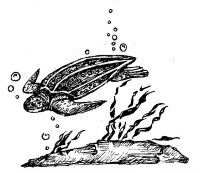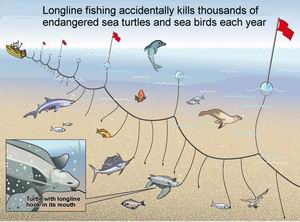
글로발 리스판스와 새만금 생명편지 쓰기 캠페인을 함께 하면서 우리가 도움만 받을 것이 아니라 세계 다른 나라에서 환경을 지키기 위해 활동하는 사람들을 응원하고 싶다는 생각이 들었습니다. 그래서 글로발 리스판스가 지금 벌이고 있는 바다거북이 구하기 캠페인을 여러분께 소개합니다.
글로벌 리스판스는 인터넷 메일 보내기 운동을 통해 전 세계에서 벌어지는 환경파괴를 막는 활동을 하고 있습니다. 1년에 평균 7개, 지금까지 총 86번의 사이버 캠페인을 펼쳤고, 그 중에서 38번을 성공했습니다. 미얀마와 루이지에나에서는 9달간 4차례에 걸쳐 항의메일운동을 펼쳐 환경파괴 사업을 저지시킨 예도 있습니다. 글로발 리스판스의 캠페인은 44%의 성공률을 보이고 있습니다.
‘삼보일배를 해도 될까요?’ 라는 편지를 보내온 파울라 팔머씨는 편지쓰는 일이 정말 세상을 바꿀 수 있을까 라고 의심 된다면 이 44%라는 수치를 기억하라고 조언합니다. 편지를 쓰는 작은 일이 우리 지구를 지켜낼 수 있습니다. 앞으로도 글로발 리스판스가 지구 곳곳에서 벌이는 지구사랑 편지쓰기 캠페인을 홈페이지를 통해 소개하도록 하겠습니다. 여러분의 정성과 마음을 모아주십시오.
바다거북이 구하기; 태평양에서 주낙식 어업을 중단하라
20003년 3~4월
| “최근 5년간 장수거북 감소 속도는 재앙에 다름아니며, 지구촌은 너무 늦기전에 가장 파괴적인 형태의 어업 방식을 중단해야만 한다. ”
— 실비아 어얼리 박사, Explorer-in-Residence, 내셔널 지오그래픽 |
보금자리를 찾는 태평양 장수바다거북이 수는 지난 80년 91,000마리에서 2002년엔 5,000마리 이하로 95%나 급감했다. 수 천마리의 바닷거북이들이 보금자리를 찾아 해마다 찾아오는 것으로 이름난 코스타리카의 플라야 그랑데와 맥시코의 멕시킬리아의 태평양 연안에 지난해 방문한 거북이 수는 각각 각각 4마리, 58마리였다.
해양과학자들은 즉각적인 대책이 취해지지 않으면 공룡시대부터 대양을 헤엄쳐온 장수거북이들이 10년 내로 멸종될 것이라고 경고한다. 지구에서 가장 큰 크기를 자랑하고, 서식 범위도 세계에서 가장 넓은 바다거북이의 위기는 다른 종의 소멸을 알리는 전조일 수도 있다.
400명 이상의 과학자와 100여개 단체들이(지난 2003년2월18일 뉴욕타임즈에 보도된 바 있는) 유엔에 보낸 공개편지에서 바다거북이들의 주요 위협은 바로 주낙(얼레에 감은 낚싯줄에 여러 개의 낚시를 달아 물속에 넣어 두고 물살에 따라 감았다 풀었다 하면서 물고기를 잡는 방법) 낚시법이라고 밝혔다. 글로벌리스판스는 태평양 심해에서 주낙식 어업과 자망식 어업을 중단할 것을 요구하는 전세계적인 활동에 동참하고 있다.
캘리포니아에 있는 바다거북이재생프로젝트에 따르면, 주낙낚시배 선주들은 황새치와 참치를 잡으려고 매년 대양에 100억개의 낚시 갈고리를 설치해 놓고 있다. 이들은 잡으려 하는 고기에 따라 다양한 깊이에 3,000개나 되는 미끼 갈고리를 매달아 놓고는 바다 표면위에서 60마일이나 되는 곳까지 어업선을 설정해 놓고 있다.
하지만 주낙식 어업은 무작위로 고기를 낚아 올리게된다. 미끼를 물거나 줄에 휘감기게 되는 새나 물고기, 혹은 해양 포유동물이 모두 잡히고 만다. 전세계적으로, 이렇게 ‘곁다리 포획’ 희생자는 연간 해산물 채취의 4분의 1을 차지하며, 보통 죽은채 혹은 죽어가는채로 선박 바깥으로 던져진다. 매년 대략 40,000 마리의 바다거북이들이 주낙식 어업으로 붙잡히고 죽어가고 있으며, 23종의 바닷새들이 멸종 위기에 처해있다.

주낙식 어업은 또한 해양자원 남획을 불러오고, 이는 대개 개발도상국 약 9억5천만명의 사람들이 주로 단백질을 공급받는 어족자원을 고갈시킨다. 유엔 보고서에 따르면 전세계 어업인구 70%가 현재 남획을 하고 있거나 남획 직전 단계에 와있다. 40년전에는 남획 어업인구가 5%에 불과했다. 식량자원의 엄청난 손실뿐 아니라, 어업자체가 불가능해지면서 소규모 어민의 생계와 해안지역사회의 관광산업을 위협하고 있다.
듀크대학교 해양연구실의 래리 크로우더 박사는, 엄격한 해안 보호정책을 펼침과 동시에 태평양에서 주낙식어업을 중단하면 장수거북이를 멸종으로부터 구해낼수 있다고 말한다. “태평양에서 주낙식과 자망식 어업은 우리 생애기간동안 끝날 것입니다. 문제는 우리가 바로 지금 이를 중단해 장수거북이들을 구해내고 어업종사들에게 도움을 줄수 있느냐, 혹은 이 어족자원이 완전히 고갈되면서 어업도 무너지고 장수거북이와 붉은바다거북이들을 아예 사멸종되도록 할 것인가 하는 기로에 서 있습니다”.
남획과 `곁다리 살상’ 증명되자 1990년대초 유엔총회는 유망어업에 대해 금지조치를 내린바 있다. 이제는 태평양에서 주낙식 어업을 중단시킬 결정을 내려야할 시기다
우리가 할 수 있는 일
유엔이 태평양에서 주낙, 자망 사용금지를 결정하도록 촉구하십시오.
| 장수바다거북이들-장수거북이는 세계에서 가장 몸집이 큰 바다거북이로, 길이는 9.5피트, 몸무게는 거의 2,000 파운드까지 자란다. 딱딱한 등껍질 대신에 가죽같은 등을 가진 유일한 바다거북이이기도 하다. 장수거북이는 다른 어떤 바다거북이보다 더 깊게 잠수하고 더 차가운 물속을 헤엄친다. 다 큰 장수거북이들은 1,500미터(거의 1마일) 깊이까지 잠수하는 것으로 알려져있다. 이 녀석들이 번식할 만큼 성장하는데는 8년에서 15년 걸린다. 다른 모든 바다거북 종류처럼, 이 녀석들은 알을 낳기위해 부화했던 해안으로 돌아온다. 바다거북이들은 공룡시대이래로 1억5천만년동안 지구에 살았다. 현재 바다거북이 7개종 모두가 위기에 처해있으며 다양한 국내법과 국제조약에 의해 보호받고 있다.
소비자 관련사항: 황새치를 먹지마세요-많은 환경단체들은 소비자들, 생선채소가게들, 식당에 두가지 이유로 황새치를 사지도 팔지도 말 것을 요구하고 있다. 황새치를 잡으려하는 주낙식 어업선박들은 특히 태평양에서 바다거북이를 `곁다리’식으로 살상하는데 책임이 있다. 미국 식약청은 황새치, 상어, 옥돔, 고등어에 높은 메틸수은(살충제용 독성)이 함유되어 있다는 이유로 임산부, 어린이, 임신가능성이 있는 여성들에게 이런 것들을 먹지말 것을 경고하고 있다. 바다거북이재생프로젝트의 웹사이트( http://www.seaturtles.org )에 가면, 주낙식 어업이 중단되고 황새치에 함유된 메틸수은 수준이 모든 사람들에게 안전함이 증명될때까지 `레드랍스터 해산물체인’에 황새치 음식을 메뉴에서 제외할 것을 요구하는 전자메일을 보낼수 있게 돼있다. |

우리가 할 일
코피 아난 유엔 사무총장에게 정중한 편지를 쓰세요. 또 이 편지를 복사해 유엔 식량농업기구(FAO)의 어업위원회 사무총장에게도 보내주세요.코피 아난 사무총장과 FAO 어업위원회에 당신이 400명이상의 과학자와 100개의 비정부기구(NGO)에 다음과 같은 내용을 촉구하는데 함께 하고 있다고 말하세요.
. “위험에 빠진 태평양 장수바다거북이들에게 심각한 해를 끼치는 주낙식과 자망식 원양어업을 중단하도록 제도화하라”:
. “어민들과 그들에 의존해 사는 공동체 마을이 지속 가능한 어업을 할 수 있도록 어획 총량을 줄일 것을 어업국들에게 촉구하라.”
. “바다를 계속적으로 사용할수 있도록하는 정책을 만들고 어민들과 지역 공동체를 지원하라”
편지 보낼 곳
Mr. Kofi Annan, Secretary General
United Nations, S-378
New York, NY 10017
팩스: Int’l code+303 449-9794
복사본 보낼 곳
Dr. Benedict P.Satia, Secretary
Committee of Fisheries, FAO
Via delle Terme di Caracalla
00100 Rome, ITALY
팩스: Int’l code+39 06 5705 6500 (or 3605)
E-mail: benedict.satia@fao.org
| 이 글로벌리스판스의 바다거북이 구하기 캠페인은 바다거북이재생프로젝트( http://www.seaturtles.org )와 코스타 리카의 PRETOMA연합( http://www.tortugamarina.org ) 로부터 제공받은 정보와 요구에 의해 개시되었습니다.
바다거북의 보존에 대해 더 궁금한 게 있으시면 http://www.seaturtles.org , http://www.tortugamarina.org , http://www.cccturtle.org/contents.htm 를 찾아오세요. |
———————————————————— 글로벌리스판스 원문
Save Sea Turtles; Stop Longline Fishing / Pacific Ocean
March – April 2003
| “The decline of the leatherback in the last five years is nothing short of catastrophic, and it is imperative that the global community come together to eliminate the use of the most destructive forms of industrial fishing before it is too late.”
— Dr. Sylvia Earle, Explorer-in-Residence, National Geographic |
The nesting population of Pacific leatherback sea turtles has plummeted from 91,000 in 1980 to fewer than 5,000 in 2002, a decline of 95%. Pacific beaches in Mexiquillo, Mexico and Playa Grande, Costa Rica that are famed for the annual arrival of thousands of nesting sea turtles, reported just 4 and 58 leatherback arrivals last year, respectively.
Marine scientists warn that unless immediate and significant steps are taken, the leatherback, which has swum the oceans since the time of the dinosaurs, will be extinct within 10 years. The plight of the world’s largest and most wide-ranging sea turtle may foreshadow a host of other extinctions.
What’s to blame, and what can be done? In an open letter to the United Nations printed in the New York Times on Feb. 18, over 400 scientists and 100 organizations said the main threat to sea turtles is longline fishing. Global Response joins a worldwide coalition in calling for a moratorium on pelagic (high seas) longline fishing and gillnetting in the Pacific.
According to the California-based Sea Turtle Restoration Project, longliners set up to 10 billion hooks in our oceans every year in their quest for swordfish and tuna. Longliners cast a fishing line up to 60 miles long on the ocean’s surface, dangling as many as 3,000 baited hooks at various depths depending on the fish they are targeting.
But longlining is non-selective; any bird, fish, or marine mammal that bites the bait or becomes entangled in the lines is caught. Worldwide, the accidental “bycatch” constitutes one quarter of the annual seafood catch and is thrown overboard, usually dead or dying. Approximately 40,000 sea turtles are caught and killed by longline operations each year, and 23 species of seabird are in danger of extinction due to impacts from longline fishing.

Longline fishing also contributes to the disastrous overfishing of ocean resources, leading to depletion and collapse of fisheries that provide the main source of protein for some 950 million people, mostly in the developing world. The United Nations reports that over 70% of global fish populations are now overfished or at the brink of being overfished, compared to just 5% reported only 40 years ago. In addition to the direct loss of a critical food resource, declining fisheries threaten the livelihoods of small-scale fishers and the tourist industry in coastal communities.
A moratorium on longline fishing in the Pacific, in combination with strict protection of nesting beaches, can save the leatherback from extinction, says Dr. Larry Crowder of the Marine Laboratory at Duke University. Dr. James Spotila of Drexel University predicts, “Longline and gillnet fishing in the Pacific will end during our lifetimes. It’s just a question of whether we stop now, while we can save the leatherbacks and provide help for the fishers. Or whether we’ll allow this fishery to collapse, at which point leatherback and loggerhead sea turtles will be long gone.”
Evidence of overfishing and wasteful bykill led the United Nations General Assembly to impose an effective ban on driftnet fishing in the early 1990s. Now is the time for equally decisive action to stop destructive longline fishing in the Pacific.
How You Can Help
Urge the United Nations to institute a moratorium on the use of longlines and gillnets in the Pacific.
| Leatherback Sea Turtles – The leatherback is the world’s largest sea turtle, growing up to 9½ feet long and weighing almost 2,000 pounds. It is the only sea turtle without a shell, having a leathery carapace instead. The leatherback dives deeper and swims into colder waters than any other sea turtle. Adult leatherbacks have been known to dive up to 1,500 meters (nearly a mile) deep. It takes leatherbacks 8 to 15 years to reach reproductive maturity. Like all other sea turtle species, they return to the beach where they hatched to lay their eggs. Sea turtles have lived on the Earth for 150 million years, since before the time of the dinosaurs. All seven species of sea turtles are endangered and protected under various national laws and international treaties. The Consumer Connection: Skip the Swordfish – Many environmental organizations are asking consumers, grocery stores and restaurants to stop buying and selling swordfish for two main reasons: 1. The longline fishing fleet that targets swordfish is responsible for most of the sea turtle “bykill,” especially in the Pacific. 2. The U.S. Food and Drug Administration warns pregnant women, children and women who might become pregnant to avoid eating swordfish, shark, tilefish and mackerel because of their high methylmercury content. At the Sea Turtle Restoration Project website ( http://www.seaturtles.org ), you can send an email to the Red Lobster seafood chain, asking them to pull swordfish from their menu until longline fishing is stopped and methylmercury levels in swordfish are found to be safe for all people. Talk to your grocer, too, and check out these recommendations for fish consumption: http://www.nrdc.org/wildlife/fish/gwhichfi.asp |

Requested Action
Please write a polite letter to Kofi Annan, Secretary General of the United Nations. Also, please send a copy of your letter to the Secretary of the Fisheries Committee, U.N. Food and Agriculture Organization (FAO).
Tell the Secretary General of the UN and the FAO Fisheries Committee that you join a coalition of over 400 scientists and 100 NGOs in urging them to:
. Institute a moratorium on pelagic (high seas) longline and gillnet fishing techniques that harm critically endangered Pacific leatherback sea turtles.
. Urge fishing nations to reduce the overall quantity of fishing to enable the long-term survival of targeted fish populations and the fishers and communities who depend on them.
. Provide transitional aid to fishers and communities who are impacted by shifts in policy that promote the sustainable use of the oceans.
Mail Your Letter To:
Mr. Kofi Annan, Secretary General
United Nations, S-3800
New York, NY 10017
FAX: Int’l code+303 449-9794
Send a copy to:
Dr. Benedict P.Satia, Secretary
Committee of Fisheries, FAO
Via delle Terme di Caracalla
00100 Rome, ITALY
FAX: Int’l code+39 06 5705 6500 (or 3605)
E-mail: benedict.satia@fao.org
| This Global Response Action was issued at the request of and with information provided by the Sea Turtle Restoration Project ( http://www.seaturtles.org ) and Asociacion PRETOMA, Costa Rica ( http://www.tortugamarina.org )
Herb Segars’ Underwater Photography: Leatherback Turtle Caught in Longline For more information on sea turtle conservation: http://www.seaturtles.org , www.tortugamarina.org; http://www.cccturtle.org/contents.htm Leatherback sea turtle photos: http://www.cresli.org/cresli/slides/crslides.html Longline fishing: http://www.hsus.org/ace/15050 , http://www.seaturtles.org/pdf/Longline_facts.pdf Ocean resources: http://www.oceansatlas.org/index.jsp , http://www.fao.org/fi/default.asp Special thanks to Erin King and Sea Turtle Restoration Project for their drawings. |
글 : 자원활동가 김성재






